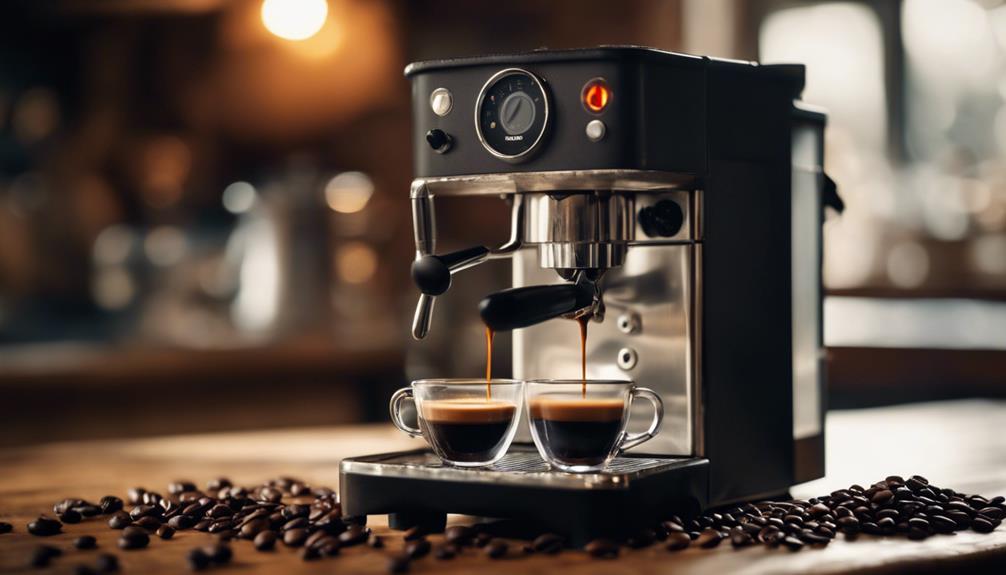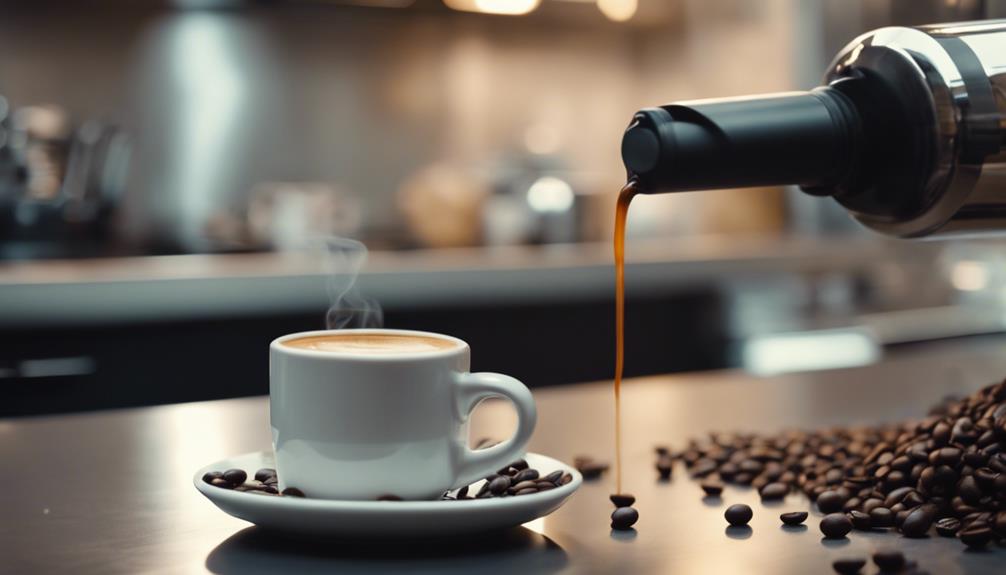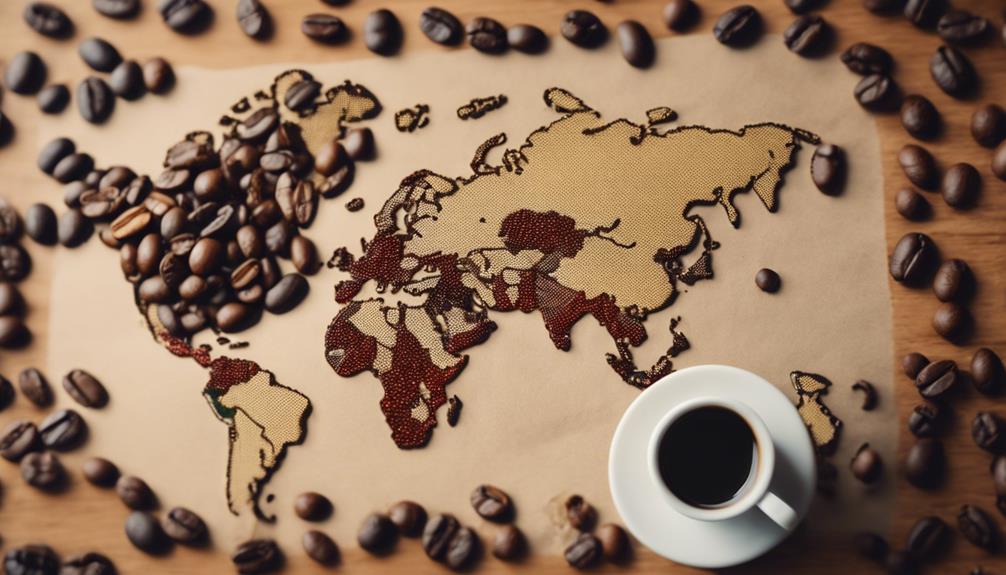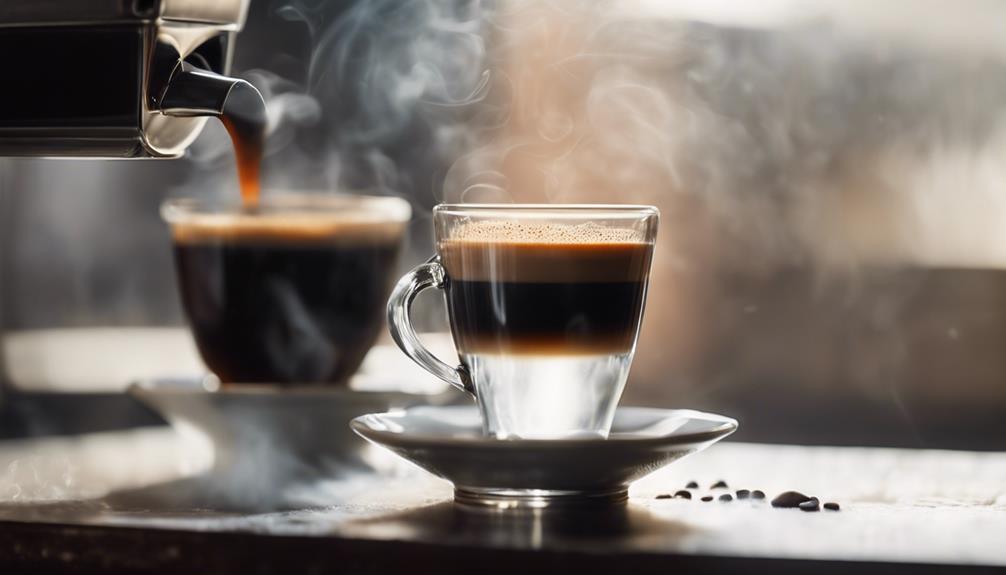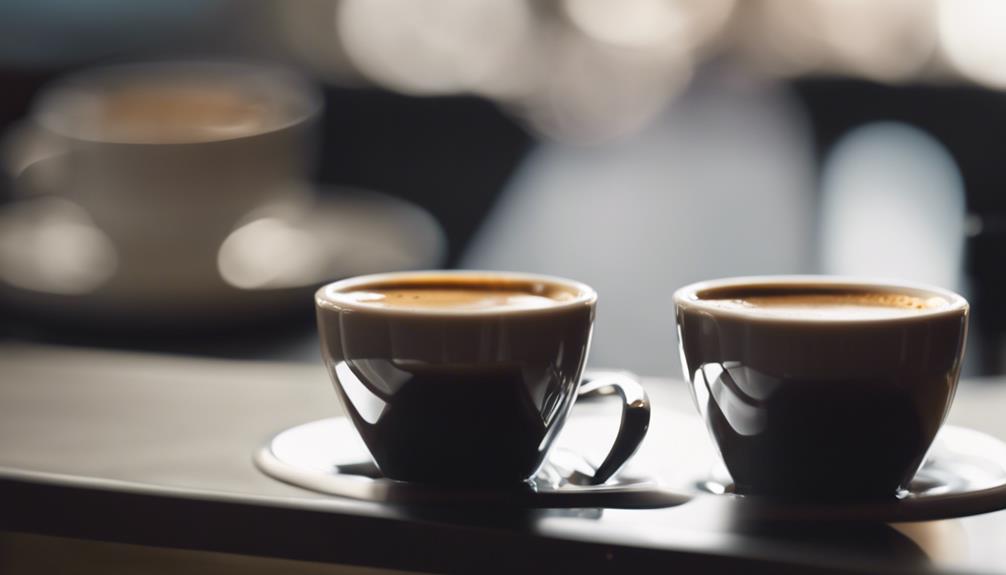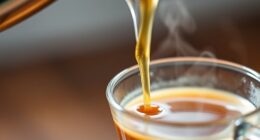You are on the verge of discovering the secrets to making a perfect shot of espresso, and it all begins with grasping the three fundamental components of brewing espresso: dose, yield, and time. To master your shot, you must carefully balance these elements, aiming for a brew ratio of 1:1 to 1:3 and a shot time of 25-30 seconds. After that, focus on adjusting your grind size, dosing, and tamping techniques to enhance extraction and achieve a well-rounded flavor profile. By refining these details, you will soon be creating espresso shots that will impress even the most discerning coffee enthusiasts – and there is more to learn to elevate your skills to the next level.
Key Takeaways
- Achieve a balanced flavor by precision-dosing 7-10g for a single shot and 20-22g for a triple shot, and monitoring yield to avoid over- or under-extraction.
- Optimize grind size to target a 25-30 second extraction time, adjusting daily as coffee ages to prevent under- or over-extraction.
- Ensure an even coffee bed by distributing grounds evenly and tamping at a 90-degree angle with 20-30 pounds of pressure.
- Monitor flow and stop the shot when it becomes pale and translucent to prevent over-extraction and achieve a target brew ratio of 1:1 to 1:3.
Mastering Espresso Recipe Components
Master the art of espresso by first grasping the three foundational components of an espresso recipe: dose, yield, and time, as even slight variations in these elements can greatly impact the flavor and quality of your shot.
You'll want to get the dose just right, as it affects the brew ratio – the ratio of coffee to liquid espresso. A typical brew ratio ranges from 1:1 to 1:3, but feel free to experiment to find your perfect balance. For instance, Clive's signature recipe uses 20g of coffee to 30g of liquid espresso, resulting in a 1:1.5 ratio.
When adjusting the dose, keep an eye on the grind size, as it affects the extraction time. If your shot takes longer or shorter than the ideal 25-30 seconds, you may need to adjust the grind size to get it just right.
The Art of Dosing and Yielding
When you're perfecting your shot of espresso, you'll find that getting the dose just right is essential.
You're aiming to measure out the ideal amount of ground coffee, which can range from 7-10g for a single shot to 20-22g for a triple shot.
Dose Measurement Matters
Your attention to detail in measuring the dose of ground coffee in the portafilter is vital, as it directly impacts the yield and flavor of your espresso shot.
When it comes to dose measurement, you'll want to aim for the recommended 7-10g for a single shot or 20-22g for a triple shot. Using a scale to measure your coffee dose in grams will guarantee consistency and replicability of your espresso shots, as even slight variations can affect the taste.
You'll also want to take into account the freshness of your coffee beans, as they can yield more crema and weigh less than older beans. This means adjusting your dose accordingly to achieve the best extraction quality.
By measuring your dose accurately, you'll be able to achieve a balanced flavor profile, like Clive's signature 1:1.5 ratio of 20g of coffee to 30g of liquid espresso.
Accurate Yield Control
Now that you've nailed the dose, it's time to focus on accurately controlling the yield of your espresso shot, as this directly impacts the flavor intensity and balance.
To achieve the perfect shot, you need to master the art of dosing and yielding.
Here are some key takeaways to keep in mind:
- Aim for the right brew ratio: Target a 1:1.5 brew ratio, which means 30-36g of espresso yield for a 16-18g dose.
- Monitor your yield: Use a scale to track the weight of your espresso shot during the pulling process, making adjustments as needed.
- Avoid over- or under-extraction: If your yield is too high, you'll get a bitter taste; if it's too low, you'll get a sour flavor.
- Fine-tune your recipe: Regularly analyze your yield in conjunction with grind size and dosing to achieve ideal flavor balance and consistency.
Perfecting Brewing Time and Flow

Now that you've mastered the art of dosing and yielding, it's time to focus on perfecting your brewing time and flow.
You'll want to aim for an ideal shot timing of 25-30 seconds, which requires making adjustments to your grind size to control the water flow.
Optimal Shot Timing
You'll want to dial in the perfect brewing time, as it's a critical factor in achieving ideal flavor extraction in your shot of espresso. Ideal shot timing is key to releasing the full potential of your coffee beans.
Here are some guidelines to help you achieve the perfect shot:
- Aim for 25-30 seconds: This is the ideal brewing time for best flavor extraction.
- Monitor the yield: You're aiming for around 30 grams of liquid espresso for a 20-gram dose of coffee using a brew ratio of 1:1.5.
- Adjust the grind: If the shot runs longer than 30 seconds, adjust the grind size to be coarser to increase water flow and reduce extraction time. If it pulls in less than 25 seconds, grind finer to slow down the flow and enhance flavor extraction.
- Watch for flow: Aim for a balanced flow that appears steady and even. A pale and translucent flow indicates the need to stop the shot for best extraction quality.
Grind Size Adjustments
With your ideal shot timing in place, it's time to fine-tune your grind size to perfect the brewing time and flow.
You'll want to aim for a medium-fine to fine grind, but be prepared to make adjustments based on your machine and coffee.
If your grind is too coarse, water will flow through the coffee bed too quickly, risking under-extraction if your shot time is under 25 seconds.
On the other hand, a grind that's too fine will slow down the water flow, potentially leading to over-extraction if your shot time exceeds 30 seconds.
As your coffee ages, you may need to make daily grind adjustments to maintain the best brewing time and flavor. Fresh coffee, for instance, often requires a slightly coarser grind.
By monitoring and adjusting your grind size, you'll be able to achieve the perfect espresso yield, with a target brew ratio of 1:1.5 (20g coffee to 30g liquid espresso) for a beautifully balanced flavor.
Flow Rate Monitoring
By closely monitoring the flow rate during extraction, you can pinpoint the ideal brewing time and flow that yields a perfectly balanced shot of espresso. This vital step allows you to adjust your grind size, tamping, and dosing to achieve the perfect brew.
Here are some key takeaways to keep in mind:
- Aim for the sweet spot: 30 grams of espresso in 25-30 seconds is the ideal range for best flavor balance.
- Grind size matters: A coarser grind increases flow rate, while a finer grind slows it down, giving you precise control over extraction time.
- Weigh your yield: Use a scale to guarantee consistency and aim for a brew ratio of 1:1.5 (20g coffee to 30g espresso) for enhanced flavor quality.
- Observe the flow: A rich, consistent flow indicates proper tamping and dosing, while a sputtery or uneven flow may suggest issues that need adjustment.
Distribution and Tamping Techniques
To achieve a perfectly balanced shot of espresso, mastering distribution and tamping techniques is vital, as it directly impacts the even extraction of flavors from the coffee grounds.
When you're preparing your shot, use a distribution tool or tap the portafilter to level the coffee bed, guaranteeing uniformity before tamping. This step is essential for even extraction, so don't skip it!
Next, it's time to tamp. Hold your tamper at a 90-degree angle and apply gentle, consistent pressure of around 20-30 pounds. Be careful not to overpack the portafilter, as this can lead to bitter shots.
Consistency is key, so regularly calibrate your tamping technique to guarantee repeatability. Don't be afraid to experiment with different tamping techniques, like the 'twist' method, to find what works best for your specific espresso and machine.
Pulling the Perfect Espresso Shot
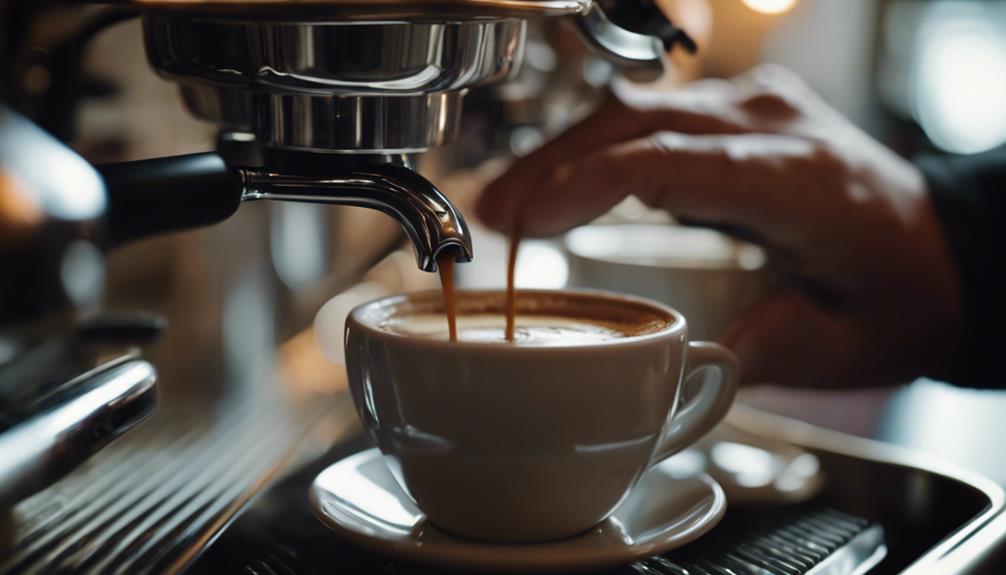
You've dialed in your distribution and tamping techniques, now it's time to focus on the moment of truth: pulling the perfect espresso shot. To achieve ideal flavor balance, follow these guidelines:
- Get the grind right: Confirm your grinder is set to a fine consistency, aiming for a 20-25 gram shot weight extracted in approximately 30 seconds.
- Measure your coffee: Use a scale to weigh out 18.5 grams of coffee for a standard double shot, maintaining a brew ratio of 1:2 for balanced extraction.
- Pre-infuse for perfection: Pre-infuse the grounds for 5 seconds to saturate them evenly before pulling the shot, which helps enhance flavor and crema.
- Monitor the extraction time: Target 25-30 seconds and adjust grind size coarseness if the shot pulls too quickly or slowly.
Remember to keep your espresso machine and portafilter clean and properly maintained to prevent off-flavors and confirm consistent shot quality.
Grinder Calibration and Adjustment
Calibrating your grinder is essential to achieving the perfect shot, as it guarantees a consistent grind size that yields ideal extraction.
To get started, set your grinder for a fine granularity, slightly coarser than powder, and use a scale that measures to 0.1 grams.
For initial calibration, load a stock double basket with 12 grams of coffee and adjust the grind to achieve a 20-25 gram shot weight in approximately 30 seconds.
Next, repeat the process using 16 grams of coffee to find a coarser grind that still meets the desired extraction time.
Remember to regularly check and adjust your grind size based on the freshness of your coffee beans, as older beans may require different settings to achieve prime extraction.
When you grind coarser, you'll need to adjust the dose to maintain the desired flavor balance in your espresso shots.
Analyzing and Balancing Flavor
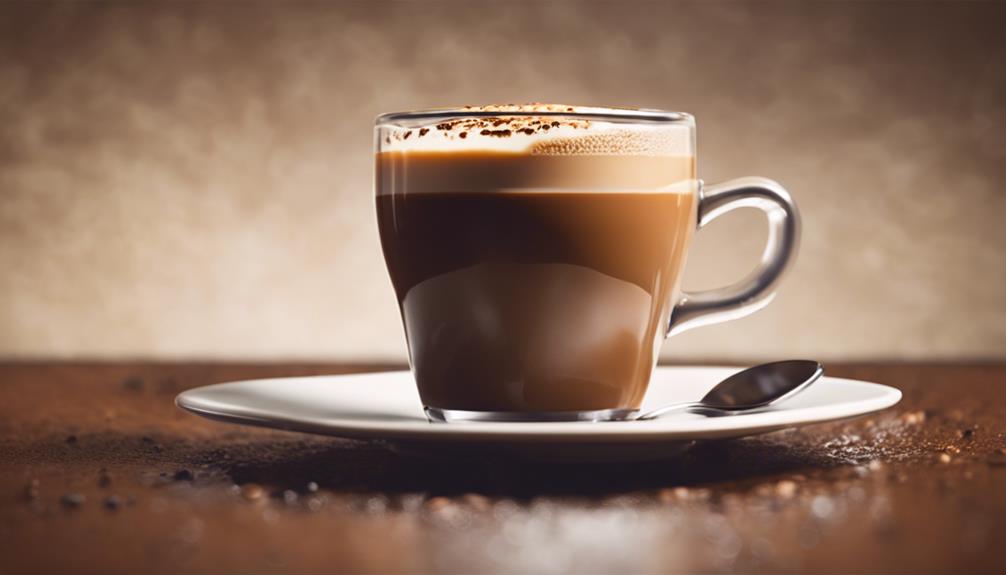
With your grinder calibrated to perfection, it's time to focus on the nuances of flavor, as a balanced harmony of sweetness, acidity, and roasty notes is what sets great espresso apart from good.
To achieve this balance, you'll need to evaluate the flavor profile of your espresso at home. Here are some tips to help you refine your flavor profile:
- Adjust the coffee type: If the overall balance is appealing but flavors are unappealing, try switching to a different coffee type to find the perfect harmony.
- Tweak the brew ratio: Aim for a typical espresso shot brew ratio of 1:2 to enhance flavor balance and achieve ideal extraction.
- Dose and grind adjustments: If your espresso tastes bland, increase the dose and coarsen the grind to reduce sugar proportion and enhance flavor richness. For overly aggressive or sour flavors, decrease the dose and use a finer grind to promote sweetness and mitigate acidity.
- Regularly taste and adjust: Continuously taste your espresso and adjust based on observed sweetness, acidity, and body to refine your flavor profile and enjoy a more balanced and enjoyable cup of fresh coffee.
Stopping the Shot and Brew Ratio
Now that you've refined your flavor profile, it's time to focus on perfecting the shot itself by mastering the art of stopping the flow and achieving the best brew ratio.
When stopping the shot, don't rely solely on timing. Instead, observe the flow and stop when it becomes pale and translucent, indicating ideal extraction.
Weighing your shots is vital for achieving the target brew ratio, which typically ranges from 1:1 to 1:3. Clive's signature recipe suggests a 1:1.5 ratio of 20g of coffee to 30g of liquid espresso.
Adjust your brew ratio according to the extraction level observed during tasting. A higher brew ratio can lead to a more intense flavor.
Recognize that the brew ratio directly influences the flavor intensity and overall balance of the espresso shot.
Tools and Techniques for Perfection

You'll need the right tools and techniques to consistently produce perfect espresso shots, and a precision scale is the first essential tool in your arsenal. This will guarantee accurate dosing, which is critical for achieving that perfect balance of flavors.
Here are the key tools and techniques to help you perfect your shot:
- Precision scale: Measure to 0.1 grams to guarantee consistent coffee weight for each shot.
- Grind adjustment: Adjust the grind size to achieve a 25-30 second extraction time, with medium-fine typically yielding the best results.
- Consistent tamping: Apply 20-30 pounds of pressure to create an even coffee bed for best extraction.
- Preheat and monitor: Preheat your espresso machine and use a bottomless portafilter to visually monitor the extraction process and identify any tamping or dosing errors.
Frequently Asked Questions
How to Get the Perfect Espresso Shot?
You're on a mission to get the perfect espresso shot! To nail it, you'll need to dial in the right coffee dose, water temperature, grind size, tamping pressure, and extraction time – it's all about finding that sweet spot! Luckily, there are expert tips for perfect espresso shots that can help guide you in achieving that elusive balance. Some key tips include using fresh, high-quality coffee beans, properly calibrating your grinder, and practicing consistent and even tamping. Additionally, experimenting with different variables and keeping detailed notes can help you fine-tune your process and find the perfect espresso shot. Another important aspect to consider is the water quality, as using filtered water can significantly improve the taste of your espresso. Moreover, ensuring that your espresso machine is properly cleaned and maintained will also contribute to the quality of your shots. By incorporating these expert tips for perfect espresso into your routine, you’ll be well on your way to consistently achieving that ideal espresso shot every time.
How Do You Make an Espresso Shot Better?
Don't you wish you could create an espresso shot that's simply divine? To make an espresso shot better, you're tweaking the grind size, adjusting the dose, and fine-tuning the brewing time to find your perfect balance of flavors.
What Are the 4 Qualities of a Perfect Espresso Shot?
You're wondering what makes a perfect espresso shot. Well, it's all about achieving four key qualities: a rich crema layer, ideal brew ratio, best extraction time, and a balanced flavor profile that hits the spot!
How Do You Make Espresso Like a Pro?
You're looking to make espresso like a pro! Start by dialing in your grinder to the perfect consistency, then measure and tamp your shot with precision, and finally, extract with confidence to achieve a rich, balanced flavor.
Conclusion
You've made it to the finish line, barista extraordinaire!
With these pro tips, you're ready to brew like a rockstar. Remember, practice makes perfect, so keep experimenting and fine-tuning your skills.
Don't be a medieval knight stuck in the dark ages – adapt to new techniques and grinder calibration. Your taste buds (and customers) will thank you.
Now, go forth and extract the perfect shot, and may the crema be with you!
